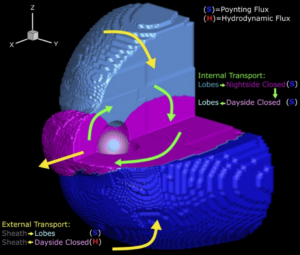One of the fundamental questions in Solar-Terrestrial research is to follow how the energy and plasma from the Sun, through the solar wind, gets into the near-Earth space and drives active processes known as geomagnetic storms and substorms. Following the plasma and energy flow requires simultaneous observations of the Sun, the solar wind, and various parts of the magnetosphere from the outer boundaries, the magnetotail, to the inner magnetosphere and ionosphere. Alternatively, large-scale numerical simulations of the solar wind – magnetosphere – ionosphere coupling offer an opportunity to examine the temporal and spatial dependences of the dynamic processes in various parts of the system. Our group focuses on combined use of observations and simulations:
- We use the Space Weather Modeling Framework (SWMF) global geospace simulation to statistically examine the large-scale response of the magnetosphere to the solar wind driver, especially during large interplanetary coronal mass ejection impacts. The simulation results are compared with satellite measurements of the plasmas and fields in space.
- We develop quantitative methods to trace the energy flow through the magnetospheric boundary to the magnetotail, the inner magnetosphere, and the ionosphere. The results are compared with empirical proxies derived from ground-based observations.
 The figure and video below are from Austin Brenner‘s thesis work, describing the different magnetic topologies of the magnetosphere (blue and magenta volumes in the figure) and the internal and external energy circulation patterns (green and yellow arrows).
The figure and video below are from Austin Brenner‘s thesis work, describing the different magnetic topologies of the magnetosphere (blue and magenta volumes in the figure) and the internal and external energy circulation patterns (green and yellow arrows).
The video shows the changing magnetospheric magnetic topology (magnetic field line connectivity, top panels) and energy flow through the outer boundary of the magnetosphere, the magnetopause (bottom panels, with blue colors showing energy outflow and brown colors showing energy entry into the magnetosphere.
